
USS Salinas (AO-19), a United States Navy Patoka-class replenishment oiler, was laid down for the United States Shipping Board (USSB) as Hudsonian (219592) on 10 April 1919 by the Newport News Shipbuilding and Dry Dock Co., Newport News, Virginia; launched on 5 May 1920; accepted by the USSB on 13 May 1920; transferred to the Navy on 29 October 1921; renamed Salinas and designated AO-19 on 3 November 1921; and commissioned at Mobile, Ala., on 16 December 1921.
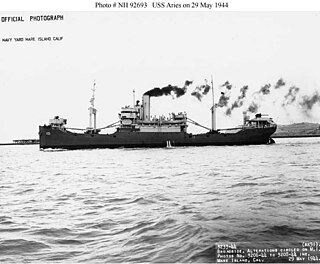
USS Aries (AK-51) (1918–1952) was a United States Navy cargo ship built as Lake Geneva under a United States Shipping Board (USSB) contract in 1918 at Duluth, Minnesota, by the McDougall Duluth Shipbuilding Company, to augment American logistics capability during World War I. The freighter was delivered to the Navy at Montreal, Quebec, Canada, on 21 September 1918 and was placed in commission the following day for service in the Naval Overseas Transportation Service. Aries was named for the constellation.

USS Algorab (AKA-8) was laid down as Mormacwren, one of the earliest Maritime Commission-type C2 ships, on 10 August 1938 by the Sun Shipbuilding & Drydock Co., Chester, Pennsylvania as hull 177 for Moore-McCormack. Mormacwren was acquired by the United States Navy 6 June 1941, commissioned 15 June 1941 as USS Algorab (AK-25) and was redesignated an attack transport on 1 February 1943 with the hull number chanted to AKA-8. Algorab decommissioned on 3 December 1945 and was delivered to the Maritime Commission on 30 June 1946 for disposal, purchased by Wallem & Co. on 4 April 1947 for commercial service.

USS Alcyone (AKA-7) was an Arcturus-class attack cargo ship named after Alcyone, the brightest star in the star cluster Pleiades. She served as a commissioned ship for five years and one month.

USS Procyon (AKA-2) was an Arcturus-class attack cargo ship of the United States Navy, named after Procyon, a star in the constellation Canis Minor. She was laid down and launched in 1940, entering service shortly before the American entry into World War II. She served with distinction in World War II, earning five battle stars. Her work included shipping planes in the Pacific, and troops in North Africa. She was part of the Invasion of Sicily and the Invasion of Okinawa. She served as a commissioned ship for 5 years and 4 months. In 1946, the ship was decommissioned, and was later sold to Levin Metals Corp. on 19 November 1973.

USS Hamul (AD-20) was the lead ship of a class of two destroyer tenders; she was most likely named after Hamal, the brightest star in the constellation Aries.

USS Salem (CM-11) was a commercial cargo ship, that served as a minelayer and then net laying ship of the United States Navy during World War II.
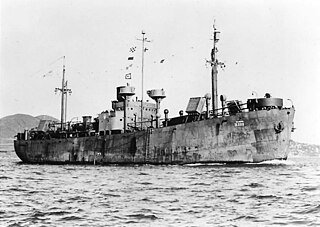
USS Pegasus was built in 1939 as SS Rita Maersk by Helsingør Jernskibs og Maskinbyggeri A/A, Helsingør, Denmark. Following the outbreak of World War II in Europe, she sailed to the United States where she operated under charter from the Maritime Commission as Rita Maersk and later as Larwin. After completing two cruises, she was laid up at Boston, Massachusetts, until 18 September 1941 when she was acquired by the United States Navy from the Maritime Commission. Renamed USS Pegasus on 15 October 1941, the cargo ship was converted for U.S. Navy use by Sullivan Drydock and Repair Corporation, New York City, and commissioned at New York on 3 December 1941.
MS Tunis was a Danish motor ship in commercial service for Det Forenede Dampskibs Selskab (DFDS), Copenhagen, Denmark, as a cargo ship delivered to DFDS on 15 January 1936. Tunis was the first of four sister ships, two built in 1936 and two in 1938, that operated for DFDS. The ship's normal service was Copenhagen to the Mediterranean until war in Europe when all four of the ships were put into Atlantic service.
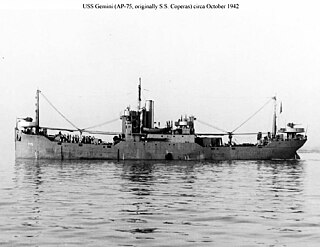
USS Gemini (AG-38/AK-52/AP-75) was a Stratford-class transport commissioned by the U.S. Navy for service in World War II. She was responsible for delivering troops and equipment to locations in the war zone.
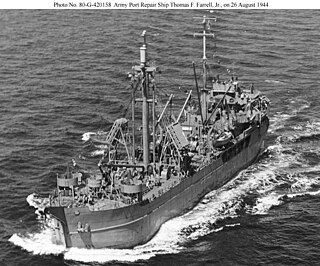
USS Hydra (AK-82), ex MV Eben H. Linnell, was an Enceladus-class cargo ship commissioned by the U.S. Navy for cargo service in World War II. Hydra was in naval service from 1 January through 19 November 1943 before she was transferred to the U.S. Army for conversion to the Engineer Port Repair ship Madison Jordan Manchester.

USS Triangulum (AK-102) was a Crater-class cargo ship commissioned by the US Navy for service in World War II. Triangulum was named after the constellation Triangulum. She was responsible for delivering troops, goods and equipment to locations in the Asiatic-Pacific Theater.
USS Pavo (AK-139) was a Crater-class cargo ship commissioned by the U.S. Navy for service in World War II, named after the constellation Pavo. She was responsible for delivering troops, goods and equipment to locations in the war zone.
USS Gadsden (AK-182) was an Alamosa-class cargo ship acquired by the U.S. Navy during the final months of World War II. She served the Pacific Ocean theatre of operations for a short period of time before being decommissioned and returned to the U.S. Maritime Administration.
USS Newcastle Victory (AK-233) was a Boulder Victory-class cargo ship acquired by the U.S. Navy during World War II. She served in the Pacific Ocean theatre of operations through the end of the war, and then returned to the United States of America for disposal.
SS Greenville Victory was a cargo Victory ship built in 1944, during World War II under the Emergency Shipbuilding program. The ship’s United States Maritime Commission designation was VC2-S-AP3, hull number 18 (V-18). Post-war she was acquired by the U.S. Army and renamed as USAT Greenville Victory. She was acquired by the U.S. Navy in 1950, renamed USNS Greenville Victory (T-AK-237) and assigned to the Military Sea Transportation Service (MSTS) who operated her safely through the Korean War and Vietnam War campaigns. She was the lead ship in her class of 9 ships that were transferred to the MSTS in 1950. She returned home with two battle stars to her credit and was struck in 1987.
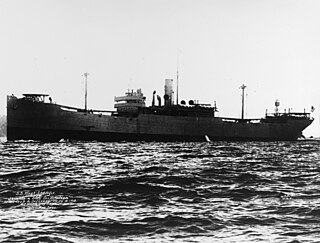
USS West Lianga (ID-2758) was a cargo ship for the United States Navy during World War I. She was later known as SS Helen Whittier and SS Kalani in civilian service under American registry, as SS Empire Cheetah under British registry, and as SS Hobbema under Dutch registry.
Empire Antelope was a 4,782-ton cargo ship which was built as Ophis in 1919. She was renamed Bangu in 1928. In 1941 she was renamed Empire Antelope. She was sunk by the German submarine U-402 on 2 November 1942.
USS West Gambo (ID-3220) was a steel-hulled, single-screw cargo ship that served in the United States Navy from 1918 to 1919. She later saw commercial service as SS West Gambo and SS Empire Hartebeeste, and under the latter name was sunk during World War II.

SS West Gotomska was a steel–hulled cargo ship built in 1918 as part of the World War I emergency wartime shipbuilding program organized by the United States Shipping Board.













